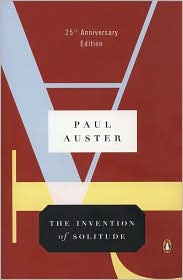Monday, November 7, 2011
The Invention of Solitude by Paul Auster 1982
"'What really struck me was the purity of his tone. As a publisher, you're always looking for tone and he had that in blinding amounts, a faintly detached, very cerebral tone,' [Robert] McCrum says." Quoted in an interview with Hadley Freeman published in The Guardian on 10/25/2002
The writer Paul Auster’s two-part memoir deals in the first half with his relationship with his father. The second part is more a philosophical meditation and intellectual inquiry into the author’s role as both father and as grandson. It also deals with the interplay between memory, the role of language in apprehending memories and the nature of solitude.
The first section of Auster’s memoir, called “Portrait of an Invisible Man,” is about his father’s absence when he was growing up. Samuel Auster, who was born in around 1911, worked long hours, leaving the house before his two children awoke and returning home after they were asleep. But more to the point, even when the author spent time with him on the weekends and holidays, he was remote and emotionally unavailable. Auster recounts vivid examples of how his father failed him, puzzling over his father’s behavior, longing for a way to reach him.
When he was adult, the frustration of having such an unsatisfactory relationship with his father drove him to learn more about him. Eventually the author was able to piece together a narrative from several sources that revealed his father’s very difficult childhood, which included a rather nomadic existence. His grandparents, Jewish immigrants from Austria, started a business in Lawrence, Kansas that failed. Eventually they settled for a while in Kanosha, Wisconsin where his father, the youngest of five, was raised during his early years. When the author was already an adult an old man from Kanosha who happened to sit next to his cousin on a plane, told a horrifying story about the Austers and directed her to newspaper articles from 1919 in the Kenosha Evening News for details.
What he learns about his father’s upbringing may help him intellectually to better understand his father’s remoteness, but does not wipe away the longing he had for a meaningful relationship. The poetic intensity of Auster’s prose heightens the effect, leaving the reader with a powerful image of a relationship that was never whole.
Although family relationships have a place in the second half of the memoir, “The Book of Memory” is a more extended meditation on life, on life cut short, on presence and absence, on the function of memory. The author writes about his own absence in his son’s life once he and his wife divorced, and also about his caring for his dying maternal grandfather which of course triggers vivid memories of their life together. Auster’s style of writing in this section is not typical of a memoir. It is both intimate and ruminative. He probes and poses difficult questions.
To watch an interview with Paul Auster discussing his writing, click here.
People
Family
Samuel Auster – brother of Harry Auster; author’s great-uncle
Harry Auster – brother of Samuel Auster; married Anna; author’s paternal grandparents
Samuel Auster – son of Harry and Anna; married Queenie
Paul Auster – son of Samuel and Queenie; author
Daniel Auster - son of Paul Auster
Elizabeth Grossman - Anna Auster's sister
Friends and Acquaintances
Fanny Koplan
Rabbi M. Hartman
Gregory Altschuller
Places
Lawrence, Kansas
Kenosha, Wisconsin
Chicago, Illinois
Weequahic section of Newark, New Jersey
New York City, New York
.
Subscribe to:
Post Comments (Atom)


No comments:
Post a Comment